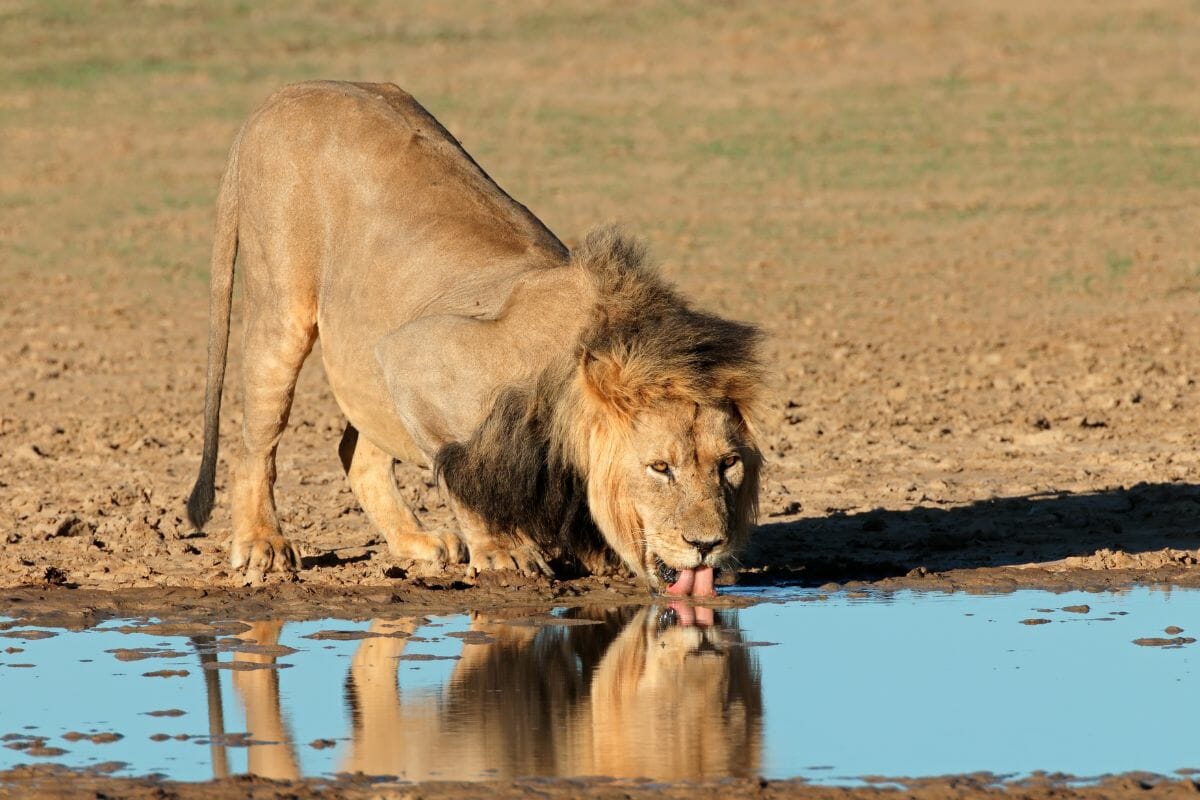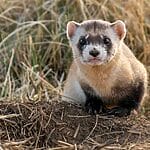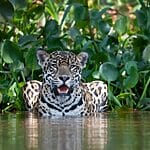Panama, the narrow land bridge connecting North and South America, is home to an astonishing array of wildlife. From the dense rainforests of Soberanía National Park to the pristine beaches of Coiba Island, this small country boasts an incredible diversity of animals.
Iconic species such as the Harpy Eagle, Jaguar, and Resplendent Quetzal share the landscape with lesser-known but equally fascinating creatures like the Panamanian Golden Frog and Rothschild’s Porcupine.
In this article, we’ll embark on a captivating journey through Panama’s diverse ecosystems, highlighting the top 20 must-see animals and the best places to spot them.
Quick Answer: Here are the top 5 notable animals found in Panama:
- Panamanian Golden Frog
- Harpy Eagle
- Geoffroy’s Tamarin
- Resplendent Quetzal
- Jaguar
Top 20 Animals to See in Panama
Panama is home to an incredible array of wildlife, from colorful birds and playful monkeys to powerful cats and bizarre-looking mammals. Here are the top 20 must-see animals in Panama, along with the best places to spot them and interesting facts about each species.
Key Takeaways:
- Panama is home to an incredible diversity of wildlife, including iconic species like the Harpy Eagle, Jaguar, and Resplendent Quetzal.
- Many of Panama’s animal species face threats such as habitat loss, poaching, and the pet trade, but conservation efforts are underway to protect them.
- Panama’s national parks and protected areas offer excellent opportunities to observe animals in their natural habitats, from the rainforests of Soberanía to the marine reserves of Coiba.
Panamanian Golden Frog
The Panamanian Golden Frog is an endemic species found only in Panama. This tiny amphibian is known for its bright yellow color and distinctive black spots. It is a symbol of Panamanian pride and holds significant cultural importance. Unfortunately, the Panamanian Golden Frog faces threats from the deadly chytrid fungus. Conservation efforts, including captive breeding programs, are underway to protect this unique species.
Harpy Eagle
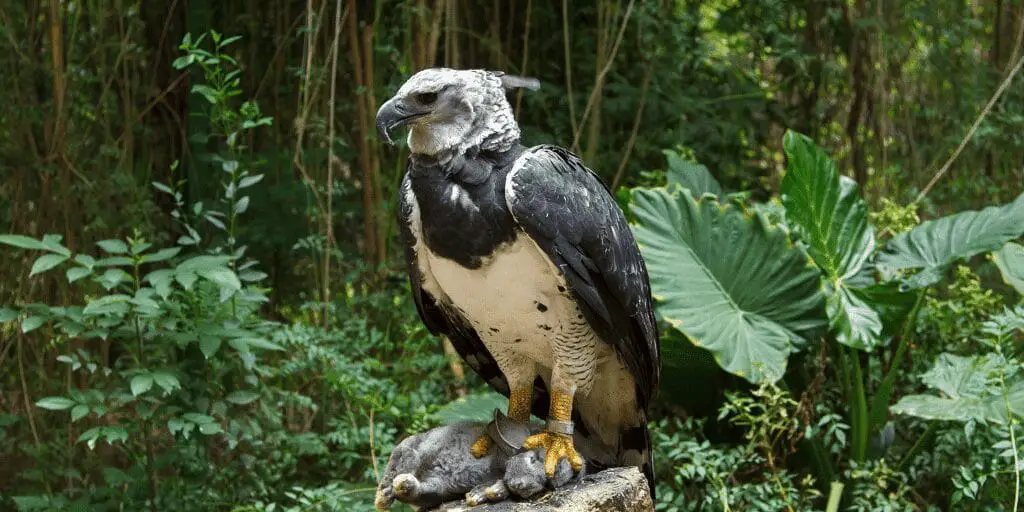
The Harpy Eagle is one of the largest and most powerful raptors in the world. With a wingspan of up to 7.5 feet, it is capable of hunting large prey, such as monkeys and sloths. The Harpy Eagle is Panama’s national bird and plays a significant role in Panamanian culture. Habitat loss and poaching pose threats to this majestic bird, but nest monitoring and community education programs are helping to protect it.
Geoffroy’s Tamarin
Geoffroy’s Tamarin is a small, adorable monkey species found in Panama. It has a distinctive white face and black fur. These social creatures live in groups of up to 20 individuals.
Geoffroy’s Tamarins play a crucial role in seed dispersal, helping to maintain healthy forests. Habitat fragmentation and the pet trade are major threats to this species, but efforts such as reforestation and anti-poaching patrols are being made to protect them.
Resplendent Quetzal
The Resplendent Quetzal is one of the most beautiful birds in the world. Its stunning iridescent green plumage and long, flowing tail feathers are truly a sight to behold.
The Resplendent Quetzal holds cultural significance in Mesoamerican mythology and is a symbol of freedom and wealth. Habitat loss and climate change pose challenges for this species, but the establishment of protected areas and reforestation projects are helping to safeguard its future.
Jaguar
The Jaguar is the largest cat in the Americas and an apex predator. With its powerful build, beautiful spotted coat, and incredible hunting abilities, the Jaguar plays a vital role in maintaining healthy ecosystems by regulating prey populations.
Habitat loss, poaching, and human-wildlife conflict are major threats to Jaguars, but the establishment of wildlife corridors and community-based conservation initiatives are helping to protect them.
Red-eyed Tree Frog
The Red-eyed Tree Frog is one of the most iconic and recognizable frog species in the world. Its striking appearance features a bright green body, blue and yellow flanks, and vibrant red eyes. These nocturnal creatures have the ability to camouflage themselves during the day.
Red-eyed Tree Frogs are indicator species for the health of rainforest ecosystems. Habitat loss and the pet trade are challenges they face, but habitat restoration and public education campaigns are working to protect them.
Capybara
The Capybara is the largest rodent in the world. With its bulky body, small head, and partially webbed feet, the Capybara is well-adapted to a semi-aquatic lifestyle. It can stay submerged for up to five minutes. Capybaras are social animals, living in groups of 10-20 individuals.
They play a role in maintaining wetland ecosystems by grazing on aquatic plants. Habitat loss and hunting pose threats to Capybaras, but the establishment of protected wetlands and sustainable hunting practices are helping to conserve them.
Three-toed Sloth
The Three-toed Sloth is one of the most beloved and iconic animals in Panama. With its shaggy fur, slow movements, and permanent smile, the Three-toed Sloth has a unique appearance. It has fascinating adaptations, such as the ability to turn its head 270 degrees and a low metabolic rate.
The Three-toed Sloth’s fur supports a diverse ecosystem, hosting algae, moths, and beetles. Habitat loss and tourist harassment are challenges they face, but sloth rescue centers and responsible tourism initiatives are working to protect them.
Keel-billed Toucan
The Keel-billed Toucan is one of the most recognizable and charismatic birds in Panama. It has a large, colorful bill and vibrant plumage, with a black body, yellow throat, and red, green, and blue markings. Keel-billed Toucans are important seed dispersers, helping to maintain the diversity of tropical forests.
They are often seen in small flocks and exhibit social behavior. Habitat loss and the pet trade are threats to this species, but the establishment of protected areas and pet trade regulations are helping to safeguard them.
White-headed Capuchin
The White-headed Capuchin is a highly intelligent and adaptable monkey species found in Panama. It has a distinctive appearance, with a white face and chest, and a dark brown body. White-headed Capuchins are known for their remarkable tool-using abilities, such as cracking nuts with rocks and using sticks to extract insects from crevices.
They have a complex social structure, living in groups of up to 40 individuals. Habitat loss and the pet trade pose challenges for this species, but the establishment of protected areas and public education campaigns are helping to protect them.
Ocelot
The Ocelot is a small wild cat species found in Panama. It has a beautiful, spotted coat and a slender build. Ocelots are nocturnal and possess excellent hunting skills, preying on small mammals, birds, and reptiles.
They play an important role in controlling prey populations and maintaining ecosystem balance. Habitat loss, poaching, and road accidents are threats to Ocelots, but the establishment of wildlife corridors and anti-poaching patrols are helping to protect them.
Baird’s Tapir
Baird’s Tapir is the largest land mammal in Central America. It has a unique appearance, with a large size, stocky build, and prehensile snout. Baird’s Tapirs are important “ecosystem engineers,” creating trails and dispersing seeds as they move through the forest.
Habitat loss, poaching, and competition with livestock are challenges they face, but the establishment of protected areas and community-based conservation initiatives are working to protect them.
Green Iguana

The Green Iguana is a large, herbivorous lizard species found in Panama. It has a striking appearance, with green scales, a spiny crest, and a powerful tail. Green Iguanas have an arboreal lifestyle and are able to swim and dive.
They play a role in seed dispersal and hold cultural significance in Mesoamerican mythology. Habitat loss, hunting for food, and the pet trade are threats to Green Iguanas, but the establishment of protected areas and regulations on hunting and trade are helping to conserve them.
Mantled Howler Monkey
The Mantled Howler Monkey is one of the loudest animals in the world. It has a distinctive appearance, with black fur and a fringe of long, golden-brown hair. Mantled Howler Monkeys are known for their amazing vocalizations, which can be heard up to three miles away.
They play an important role in seed dispersal and have a complex social structure, living in groups of up to 20 individuals. Habitat loss and yellow fever outbreaks pose challenges for this species, but the establishment of protected areas and disease monitoring programs are working to protect them.
Scarlet Macaw
The Scarlet Macaw is one of the most beautiful and iconic bird species in Panama. It has vibrant red, yellow, and blue plumage and a large, powerful beak. Scarlet Macaws are known for their intelligence and ability to mimic human speech. They play an important role in seed dispersal and hold cultural significance in indigenous Panamanian art and folklore.
Habitat loss, poaching for the pet trade, and competition with invasive species are threats to Scarlet Macaws, but the establishment of protected areas, captive breeding programs, and community-based conservation initiatives are helping to protect them.
Giant Anteater
The Giant Anteater is one of the most unique and fascinating mammals in Panama. It has a distinctive appearance, with a long snout, bushy tail, and shaggy fur. Giant Anteaters have a specialized diet of ants and termites and an incredible sense of smell. They play an important role in controlling insect populations and maintaining ecosystem balance.
Habitat loss, road accidents, and hunting for bush meat are challenges Giant Anteaters face, but the establishment of protected areas and public education campaigns are working to protect them.
Black-headed Spider Monkey
The Black-headed Spider Monkey is a large, agile monkey species found in Panama. It has a distinctive appearance, with a black head, long limbs, and a prehensile tail. Black-headed Spider Monkeys have an arboreal lifestyle and are able to move quickly through the treetops.
They play an important role in seed dispersal and have a complex social structure, living in groups of up to 30 individuals. Habitat loss, hunting, and the pet trade pose threats to this species, but the establishment of protected areas and the enforcement of wildlife trade laws are helping to protect them.
Coiba Island Howler Monkey
The Coiba Island Howler Monkey is a subspecies of the Mantled Howler Monkey found only on Coiba Island, Panama. It has a distinctive appearance, with golden-brown fur and a slightly smaller size compared to its mainland counterparts. Coiba Island Howler Monkeys have unique vocalizations and adaptations to the island environment.
As an endemic subspecies, they play an important role in the island’s ecosystem. Limited habitat and potential impacts from tourism are challenges they face, but the establishment of Coiba National Park and responsible tourism practices are working to protect them.
Rothschild’s Porcupine
Rothschild’s Porcupine is a nocturnal rodent species found in Panama. It has a distinctive appearance, with a stocky body, short legs, and sharp quills. Rothschild’s Porcupines are herbivorous and have the ability to climb trees.
They play an important role in seed dispersal and use their quills for defense against predators. Habitat loss and hunting for bush meat are threats to this species, but the establishment of protected areas and public education campaigns about their ecological importance are helping to protect them.
Panama Flycatcher
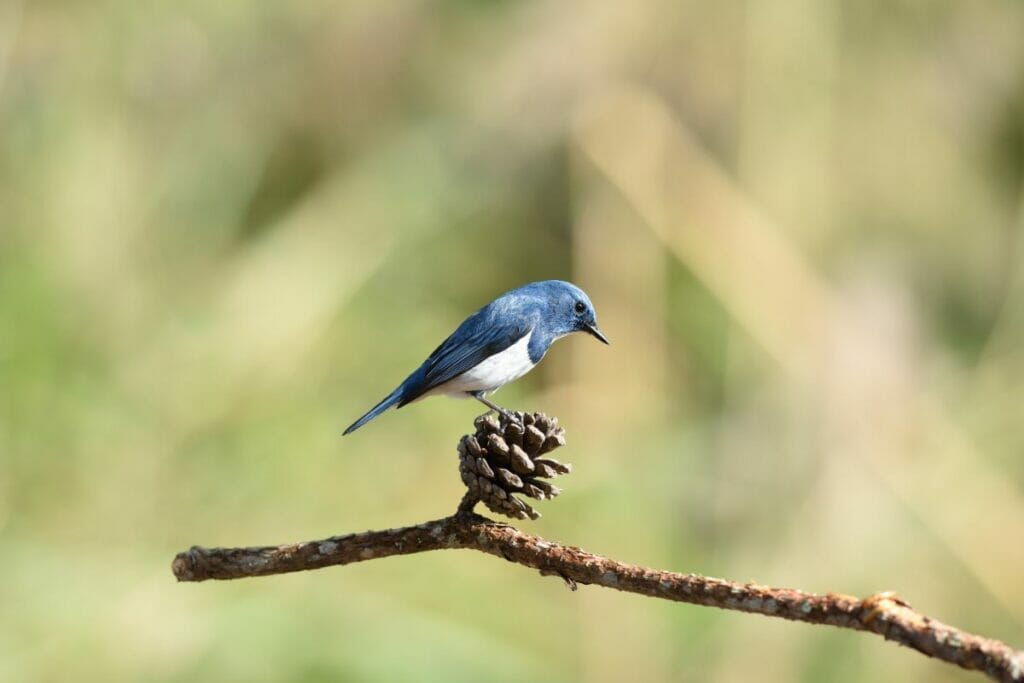
The Panama Flycatcher is a small, endemic bird species found only in Panama. It has a distinctive appearance, with olive-green upperparts, yellow underparts, and a gray head. Panama Flycatchers have an insectivorous diet and play a role in controlling insect populations.
As an endemic species with a limited range, they are of particular conservation concern. Habitat loss and competition with invasive bird species are challenges they face, but the establishment of protected areas and research into their ecology and conservation needs are working to protect them.
Where to Find Wildlife in Panama
Panama is a nature lover’s paradise, offering a wide range of diverse ecosystems and habitats that are home to an incredible array of wildlife. From lush rainforests and misty cloud forests to pristine beaches and coral reefs, Panama’s national parks, reserves, and protected areas provide excellent opportunities to observe animals in their natural surroundings. Here are some of the best places to find wildlife in Panama:
Soberanía National Park is a tropical rainforest located just a short drive from Panama City. This park is known for its incredible biodiversity, with over 525 species of birds, 105 species of mammals, and 79 species of reptiles. Visitors can explore the park’s extensive trail network, including the famous Pipeline Road, which is considered one of the best bird-watching spots in the world. S
ome of the notable animals found in Soberanía National Park include the Geoffroy’s Tamarin, White-faced Capuchin, Hoffmann’s Two-toed Sloth, and the elusive Jaguar.
Darién National Park, located in eastern Panama near the border with Colombia, is the country’s largest and most remote protected area. This vast wilderness encompasses a variety of habitats, from lowland rainforests to montane cloud forests and mangrove swamps.
Darién is home to an astonishing diversity of wildlife, including the Harpy Eagle, Great Curassow, Black-headed Spider Monkey, and the endangered Central American Tapir. Due to its remote location, visiting Darién requires careful planning and the assistance of experienced guides.
Coiba National Park, situated off the Pacific coast of Panama, is a marine reserve and UNESCO World Heritage Site. The park encompasses Coiba Island, the largest island in Central America, as well as 37 smaller islands and the surrounding marine areas.
Coiba’s pristine forests and waters are home to a wide variety of wildlife, including the Coiba Island Howler Monkey, Crested Eagle, Scarlet Macaw, and numerous species of whales and dolphins. Visitors can explore the island’s hiking trails, go snorkeling or diving in the coral reefs, or take a boat tour to spot marine life.
The Chiriquí Highlands, located in western Panama near the border with Costa Rica, are known for their stunning cloud forests, coffee plantations, and cooler temperatures. This region is home to several protected areas, including La Amistad International Park and Volcán Barú National Park.
The Chiriquí Highlands are a birdwatcher’s paradise, with species such as the Resplendent Quetzal, Three-wattled Bellbird, and Volcano Hummingbird. Other notable animals found in this region include the Baird’s Tapir, Puma, and Olingo.
The Bocas del Toro Archipelago, situated off the Caribbean coast of Panama, is a popular destination for beach lovers and nature enthusiasts alike. The archipelago consists of nine main islands and numerous smaller islets, each with its own unique character and wildlife.
Visitors can go snorkeling or diving to explore the colorful coral reefs, take a boat tour to spot dolphins and sea turtles, or hike through the lush rainforests of Isla Bastimentos National Marine Park. Some of the notable animals found in Bocas del Toro include the Red-billed Tropicbird, Three-toed Sloth, and White-faced Capuchin.
For those short on time or looking for a wildlife experience close to Panama City, the Metropolitan Natural Park offers a convenient option. This protected area, located within the city limits, is home to a surprising diversity of wildlife, including sloths, monkeys, iguanas, and numerous bird species.
Visitors can hike the park’s trails, climb the observation tower for panoramic views of the city and the Panama Canal, or take a guided nature walk to learn about the park’s flora and fauna.
When planning a wildlife-watching trip to Panama, it’s important to consider the best times of year to visit each location. The dry season, which runs from mid-December to mid-April, is generally the best time for wildlife spotting, as animals are more active and visible when water sources are scarce. However, some parks and reserves, such as Darién and the Chiriquí Highlands, can be visited year-round.
To increase your chances of spotting wildlife, consider hiring a local guide or joining an eco-tour. Experienced guides have a wealth of knowledge about the animals and their habitats, and can help you locate and identify species that you might otherwise miss. Many of Panama’s national parks and reserves offer guided tours, ranging from short nature walks to multi-day treks.
By exploring Panama’s diverse protected areas and supporting responsible eco-tourism initiatives, visitors can enjoy unforgettable wildlife encounters while contributing to the conservation of the country’s natural heritage. Whether you’re a seasoned birdwatcher, a marine life enthusiast, or simply a nature lover, Panama’s national parks and reserves offer something for everyone.
Frequently Asked Questions
What is the best time of year to visit Panama for wildlife watching?
The dry season, which runs from mid-December to mid-April, is generally the best time for wildlife spotting in Panama, as animals are more active and visible when water sources are scarce.
Are there any wildlife experiences close to Panama City?
Yes, the Metropolitan Natural Park, located within Panama City limits, offers a convenient option for those looking for a wildlife experience close to the city. Visitors can hike trails, climb the observation tower, and spot sloths, monkeys, iguanas, and numerous bird species.
How can I increase my chances of spotting wildlife in Panama?
To increase your chances of spotting wildlife in Panama, consider hiring a local guide or joining an eco-tour. Experienced guides have a wealth of knowledge about the animals and their habitats and can help you locate and identify species that you might otherwise miss.
What should I pack for a wildlife-watching trip to Panama?
When packing for a wildlife-watching trip to Panama, be sure to bring lightweight, breathable clothing, sturdy hiking shoes, insect repellent, sunscreen, a hat, binoculars, and a camera. It’s also a good idea to pack a waterproof jacket or poncho, as tropical showers can occur throughout the year.
How can I contribute to wildlife conservation efforts in Panama?
By supporting responsible eco-tourism initiatives and visiting Panama’s national parks and protected areas, you can contribute to the conservation of the country’s natural heritage. Additionally, you can make donations to local conservation organizations or participate in volunteer programs focused on wildlife protection and habitat restoration.
- Wild Animals in Costa Rica: A Biodiverse Paradise - 2024-05-16
- Animals That Live in the Rainforest: A Diverse Wonder - 2024-05-15
- Animals in the Safari: A Captivating African Adventure - 2024-05-15



